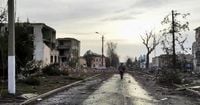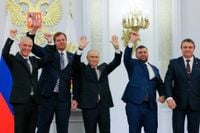Three and a half years after Russian President Vladimir Putin launched his full-scale invasion of Ukraine, the war’s front lines remain stubbornly fluid, shifting with every new offensive and diplomatic twist. As the conflict enters a pivotal phase, the world is watching closely, especially in light of the recent summit between Putin and U.S. President Donald Trump in Alaska—a meeting that could signal a new chapter, or simply another turn, in this enduring struggle.
It all began on February 24, 2022. According to The Associated Press, Russian troops surged into Ukraine from the north, east, and south, making a rapid push toward Kyiv’s outskirts. The world held its breath as the capital seemed to teeter on the brink. Yet, Ukrainian resistance proved fierce. By March 5, Russian advances toward Kyiv and Kherson had reached their zenith, with the port city of Mariupol surrounded and under siege. But the tide soon shifted. On April 2, Ukraine’s forces managed to repel Russian troops from Kyiv and Chernihiv, marking the first major setback for Moscow in what many thought would be a swift campaign.
The months that followed saw a relentless back-and-forth. On August 29, 2022, Ukraine launched its first counteroffensive in the east and south, aiming to reclaim lost ground. Just a month later, on September 30, Russia responded with a dramatic move: the illegal annexation of Donetsk, Luhansk, Kherson, and Zaporizhzhia regions. The Kremlin staged what it called “referendums,” but the world largely dismissed them as a sham, especially since Russian forces didn’t even fully control these territories. Putin’s signing ceremony in Moscow, flanked by Moscow-appointed regional heads, was broadcast as a show of strength, but the reality on the ground was far messier.
Between September and November 2022, Ukrainian forces clawed back vast swathes of Kharkiv, Mykolaiv, and Kherson regions, including the symbolic recapture of Kherson city. The Associated Press reports that this period marked some of the war’s most dramatic territorial reversals, underscoring the unpredictability of the conflict. Yet, the pendulum continued to swing. On May 22, 2023, Russia announced it had seized control of Bakhmut after months of grinding combat—a battle that left both sides battered and world leaders scrambling to reassess their strategies.
June 2023 brought another shock: as Ukraine prepared for its second major counteroffensive, the Russian-controlled Kakhovka Dam exploded, sending a wall of water cascading through southern Ukraine. The flooding upended Ukrainian battle plans and displaced thousands, adding a grim new dimension to the humanitarian crisis. Despite these setbacks, Ukrainian forces pressed on, though by the fall of 2023, the second counteroffensive had ground to a halt with little change to the front line.
As the war dragged into its third year, the costs mounted. On February 18, 2024, Russian troops finally took complete control of Avdiivka, another eastern city that had become a symbol of Ukrainian resistance. The fighting was relentless, with both sides suffering heavy losses. Meanwhile, international support for Ukraine became a political football. After months of debate, the U.S. House of Representatives approved a $61 billion aid package for Ukraine on April 19, 2024, injecting much-needed resources into Kyiv’s war effort but also highlighting deep divisions in Washington about America’s role in the conflict.
May 2024 saw Russia opening a new front in northeastern Kharkiv, capturing several villages and threatening to widen the war. But Ukraine was not without surprises of its own. On August 6, 2024, Ukrainian forces launched a lightning incursion into Russia’s Kursk region, briefly holding territory along the border—a move that caught the Kremlin off-guard and embarrassed Moscow’s military planners. The episode was short-lived, however. By April 26, 2025, Moscow declared all Ukrainian troops had been expelled from Kursk, and Putin himself visited the area, meeting with local volunteers in a carefully staged display of strength.
The war’s technological dimension also escalated. On June 1, 2025, Ukraine struck airfields deep inside Russia using drones in a covert operation dubbed “Spider Web.” These drones, transported secretly across the country on trucks, demonstrated Kyiv’s growing ability to hit targets far beyond the front lines. That summer, both sides ramped up drone strikes, with each showing an increasing capacity to strike deep into enemy territory—a chilling sign of how quickly the conflict’s tools were evolving.
Territorial shifts continued apace. On June 30, 2025, Russia claimed full control of Luhansk, one of the four regions it had annexed in 2022. A month later, on July 31, Russian forces announced they had seized Chasiv Yar, a strategically vital city after months of fierce fighting. By August, the Kremlin’s troops were pressing further into the Donetsk region, capturing small villages and closing in on Pokrovsk, another city of significant strategic value.
Amid these military maneuvers, diplomacy took center stage. On January 20, 2025, Donald Trump was inaugurated as the 47th president of the United States, injecting new uncertainty into the international calculus. Would the U.S. continue to back Ukraine as robustly as before? Allies and adversaries alike watched for clues. The answer, it seemed, would come at the highest level. On August 15, 2025, Putin and Trump met in Alaska for the first Russia-U.S. summit in four years. According to European officials and Ukrainian President Volodymyr Zelenskyy, Putin used the meeting to push for a deal: Ukraine would have to withdraw from the remaining 30% of Donetsk it still controlled. The Associated Press notes that, while peace talks are ongoing, the terms remain a subject of fierce debate in Kyiv, Moscow, and Western capitals.
The current phase of the war is marked by both exhaustion and escalation. Russia’s slow, grinding advances in the east and north, coupled with Ukraine’s tenacious counterattacks and bold strikes inside Russia, have created a stalemate punctuated by moments of dramatic change. The fate of cities like Pokrovsk and the outcome of high-level diplomacy could determine whether the war drags on or finally moves toward resolution.
As the world waits for the next move—on the battlefield or at the negotiating table—one thing is clear: the conflict in Ukraine has become a defining struggle of the decade, with consequences that will echo far beyond its shifting front lines.



